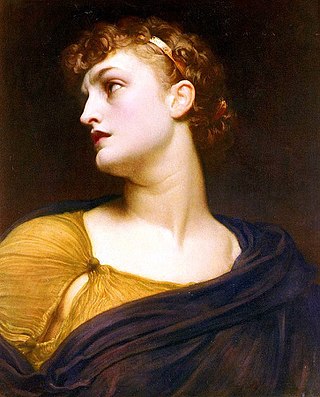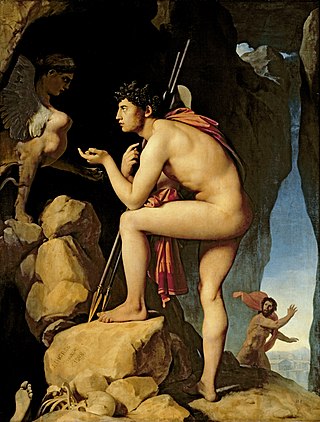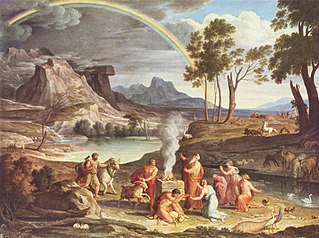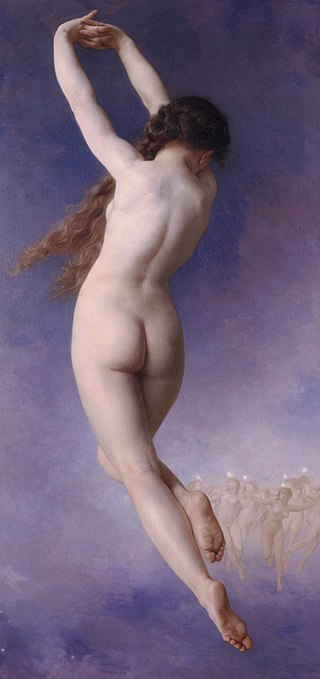
Incest is found in folklore and mythology in many countries and cultures in the world. [1] [2] [3] [4] [5]

Incest is found in folklore and mythology in many countries and cultures in the world. [1] [2] [3] [4] [5]
In Greek mythology, Gaia (earth) had 12 children with her own son Uranus (sky). [6] [7] She bore six male and six female Titans to her son, Uranus (sky). The male Titans were Oceanus, Coeus, Crius, Hyperion, Iapetus, and Cronus. The female Titans were Theia, Rhea, Themis, Mnemosyne, Phoebe, and Tethys. Oceanus, Coeus, Hyperion and Cronus each consorted with one of their sisters and mated with them, producing offspring of their own, [6] while Themis and Mnemosyne became wives of their nephew Zeus, [8] Iapetus married his niece Clymene, [9] and Crius married his half-sister Eurybia. [10]
Zeus also fathered a daughter, Persephone, with his other older sister, Demeter. [11] However, the orphic sources claim that Persephone was instead the daughter of Zeus and his mother Rhea. [12]
Nyx and Erebus were also married siblings. The sea god Phorcys fathered many offspring by his sister Ceto.
Among the many lovers of Zeus, some were his daughters. Persephone is the daughter of Demeter and her brother Zeus, and becomes the consort of her uncle Hades. Some legends indicate that her father impregnated her and begat Dionysus Zagreus. Other examples include Zeus's relations with the Muse Calliope, Aphrodite (his daughter in some versions) and Nemesis (his daughter in one tradition).
Horus, the grandson of Geb, had his own mother, Isis, become his imperial consort. [14]
The goddess Hathor was simultaneously considered to be the mother, wife, and daughter of the sun god Ra. [15] Hathor was also occasionally seen as the mother and wife of Horus. [16] [17] [18] [19] [20] [21] [22] [23] [24] [25] [26] [27] [28] [29] [30] : 107–115, 122–123, 145–146, 153–156, 187–188, 202–203 [31] [32] [33] [34]
In Egyptian mythology, there are frequent sibling marriages. For example, Shu and Tefnut are brother and sister and they produce offspring, Geb and Nut. [7] [35]
The patron god on the Incas, Inti, is married to his elder sister Mama Quilla.
Oedipus-type tales are stories that are very similar to Oedipus Rex , which is the most famous tale of mother–son incest. They start with the warning of the fated incest and, in response, the mother deserts her child. If his mother is a queen, princess, or an aristocrat, the son distinguishes himself among her suitors by accomplishing a certain task, thereby earning her hand in marriage as a part of the reward. However, the hero's desertion as a child makes plausible that neither the son nor mother recognize each other, leading to an inadvertent, incestuous consummation. For example, in the Indonesian legend of Tangkuban Perahu, Princess Dayang Sumbi weds a warrior, unaware he is her son, when he succeeds in recovering a prized weaving needle she lost, and the ancient Greek king Oedipus and his mother Jocasta are also setup for marriage in a similar way. If the mother and son learn the truth about their relationship, it is usually after they wed. [36]
For example, in the aforementioned Indonesian legend, Princess Dayang Sumbi, while laying aside her sleeping husband, recognizes the scar on his chest as her son's. [37]
[38] : 4, 12, 32, 39–51, 57–60, 90–91, 113–114, 124–125, 138–140, 243
Another way the mother-wife discovers the incest in the wedding bed is by an object that she had kept with the baby. The timing of the discovery varies from one night to many years and in some cases, as far as after multiple children are born.
In the original tale, for example, Jocasta bears her son four children: Eteocles, Polynices, Antigone, and Ismene. [39] [38] : 4, 39–51, 57–60, 90–91, 113–114, 124–125, 138–140, 243
The core plot, having entered into the world of folklore, is found in folktales of various nations like Greece, Indonesia, India, Albania, Britain, Malaysia, Iran, etc. [11]
In another myth, which went among the Miao people in the Yunnan Province, a great flood leaves only a mother and her young son alive. The mother accidentally eats a nut that transforms her into a young woman. [40]
Numerous variants of brother-sister unions following the flood are found from the Bhuiya, Maria, Bondo, Gabada, Kond, Saora and Kol among the tribal area of central India. A variant of mother-son union following the flood is reported from the Gabada of the same location too. [43]
In an Udege myth, a girl and her younger brother are the sole survivors of a great flood. They became the progenitors of the whole human race. [44]
From Taiwan alone come twenty-eight versions of a brother-sister pair living as husband and wife to become the progenitors of mankind after a great flood. [45]
The Mandaya of Mindanao have a myth of a big flood killing all except a pregnant lady. A son, named Uacatan (Watakan), is born to her. When the son grows up, he weds his mother, and from this union all humans arise. [43] [47] [48]
In the Philippines, brother-sister marriages following a flood are reported from the Ifugao, Isneg, and Igorot. [43]
Myrrha committed incest with her father, Theias, and bore Adonis.
Thyestes raped his daughter Pelopia after an oracle advised him that a son born of them would be the one to kill Atreus, Thyestes' brother and rival.
In some versions of the story of Auge and her son by Heracles, Telephus, the two were nearly married before Heracles revealed the truth of their relation.
Nyctimene was seduced or raped by her father, King Epopeus of Lesbos. In her shame, she avoided showing herself by day, and Athena turned her into an owl.
Njörðr is sometimes said to be married to Skaði, while other times he's said to be married to his unnamed sister. Ynglinga saga chapter 4, provides an example of the latter, characterizing their union as a Vanir custom:
Old Norse
- Þá er Njǫrðr var með Vǫnum, þá hafði hann átta systur sína, því at þat váru þar lǫg; váru þeira bǫrn Freyr ok Freyja. [52]
Lee M. Hollander translation (1992)
- While Njorth lived with the Vanir he had his sister as wife, because that was the custom among them. Their children were Frey and Freya. [53]
In Norse legends, the hero Sigmund and his sister Signy murdered her children and begot a son, Sinfjötli. When Sinfjötli had grown up, he and Sigmund murdered Signy's husband Siggeir. The element of incest also appears in the version of the story used in Wagner's opera-cycle Der Ring des Nibelungen , in which Siegfried is the offspring of Siegmund and his sister Sieglinde.
The legendary Danish king Hrólfr kraki was born from an incestuous union of Halgi and Yrsa. [54]
In Chinese mythology, Fu Xi is a king and creator god who takes his sister, the goddess Nüwa, as his bride. [55] [56] [57]
In Icelandic folklore a common plot involves a brother and sister (illegally) conceiving a child. They subsequently escape justice by moving to a remote valley. There they proceed to have several more children. The man has some magical abilities which he uses to direct travelers to or away from the valley as he chooses. The siblings always have exactly one daughter but any number of sons. Eventually the magician allows a young man (usually searching for sheep) into the valley and asks him to marry the daughter and give himself and his sister a civilized burial upon their deaths. This is subsequently done.
In the Old Irish saga Tochmarc Étaíne ("The Wooing of Étaín"), Eochaid Airem, the high king of Ireland is tricked into sleeping with his daughter, whom he mistakes for her mother Étaín. The child of their union becomes the mother of the legendary king Conaire Mor.
In some versions of the medieval British legend of King Arthur, Arthur accidentally begets a son by his half sister Morgause in a night of blind lust, then seeks to have the child killed when he hears of a prophecy that it will bring about the undoing of the Round Table. The child survives and later becomes Mordred, his ultimate nemesis. [58]
Danand, a minor character in Irish mythology, is said to have conceived three sons with her own father. [59] [60]
In an ancient Vietnamese folklore, there is a tale of a brother and a sister. As children, the brother and sister fought over a toy. The brother smashes a stone over his sister's head, and the girl falls down unconscious. The boy thinks he has killed his sister, and afraid of punishment, he flees. Years later, by coincidence, they meet again, fall in love, and marry without knowing they are siblings. They build a house along a seashore, and the brother becomes a fisherman while his sister tends to the house. Together they have a son. One day, the brother discovers a scar on his wife's head. She tells him about the childhood fight with her brother, and the brother realizes that he has married his own sister. Overwhelmed with guilt over his incest, the brother goes out on the sea. Every day, the sister climbs to the top of the hill to look for her brother, but he never comes back. She died in waiting and became "Hon Vong Phu" ("the stone waiting for her husband"). [61] [62] [63] [64] [65] [66] [67] [68] [69] [70]
In a tale from Uganda, a youth called Uken was having a playful argument with his mother. "Now you are old, mother," said he. "But was I not a girl once too?" countered his mother, "surely if I dressed up the men young as you would look at me still! "Really, mother," answered Uken, "you who are all old now, who do you think would look at you?" Now when his mother heard what he said, his words sank deep in her heart. The next morning Uken was exchanging promises with a girl friend, and the girl promised that she would come to him that night. Meanwhile, Uken's mother wanted to disprove her son's earlier opinion of her. She stripped off all her old skin and there she was with complexion as clear as long ago when she had been a girl. Then she went to her son's sleeping place, and waited for him, wanting to see his reaction. She waited and waited but sleep began to overwhelm her and overwhelmed her it did. By the time the youth came back from his walk it was night. He found his mother asleep on his sleeping place. She looked so young and beautiful from head to foot, glistening with the oil she had used to anoint her body, and wearing beads of many kinds.' There she was lying on his sleeping place. So when her son came and entered the hut his eye lit up at the thought that perhaps the girl who had made him promises had really come. And so he lay with his mother that night. At first light his mother went out and left him on the bed. She had never intended for this to happen nor did she think her son knew he had spent the night sleeping with his mother as if he was her husband so she decided she would take this secret to her grave. She returned to her hut and put on her old skin. Then when morning came Uken got up and went to his mother's hut to ask her for food, and once again made some comment about her old age. Hearing that, she could not help herself and said "Your mother, your mother, did you know that just a few hours ago you were enjoying the night with this old lady?" Uken was shocked, and knew it to be true as he realized the moans and sighs of his woman last night matched the voice of his mother. Mortified and embarrassed, never again did he disrespect his mother's appearance. [71]
In fairy tales of Aarne-Thompson folktale type 510B, the persecuted heroine, the heroine is persecuted by her father, and most usually, the persecution is an attempt to marry her, as in Allerleirauh or Donkeyskin . This was taken up into the legend of Saint Dymphna. In addition, stories of tale type ATU 706, "The Maiden Without Hands", also show the motif of attempted fatherly incest connected with the mutilation of the heroine. [72]
Several child ballads have the motif of incest between brothers and sisters who are raised apart. This is usually unwitting (as in The Bonny Hind and Sheath and Knife , for example), but always brings about a tragic end.

Metis, in ancient Greek religion and mythology, was one of the Oceanids. She is notable for being the first wife and advisor of Zeus, the King of the Gods. She helped him to free his siblings from their father Cronus' stomach by giving him an emetic and, when she was swallowed by Zeus after it was foretold that she would bear a son mightier than his father, helped their daughter Athena to escape from his forehead.

In Greek mythology, Antigone is a Theban princess, and a character in several ancient Greek tragedies. She is the daughter of Oedipus, king of Thebes. Her mother is Jocasta. In another variation of the myth, her mother is Euryganeia. She is a sister of Polynices, Eteocles, and Ismene. The meaning of the name is, as in the case of the masculine equivalent Antigonus, "in place of one's parents" or "worthy of one's parents". Antigone appears in the three 5th century BC tragic plays written by Sophocles, known collectively as the three Theban plays. She is the protagonist of the tragedy Antigone. She makes a brief appearance at the end of Aeschylus' Seven against Thebes, while her story was also the subject of Euripides' now lost play with the same name.

Oedipus was a mythical Greek king of Thebes. A tragic hero in Greek mythology, Oedipus fulfilled a prophecy that he would end up killing his father and marrying his mother, thereby bringing disaster to his city and family.

In Greek mythology, Polynices was the son of Oedipus and either Jocasta or Euryganeia and the older brother of Eteocles. When Oedipus was discovered to have killed his father and married his mother, Oedipus was expelled from Thebes, leaving Eteocles and Polynices to rule. Because of a curse put on them by their father, the two sons did not share the rule peacefully. During a battle for control over Thebes, the brothers killed each other.

Clotho or Klotho, is a mythological figure. She is the youngest goddess of the Three Fates or Moirai. In ancient Greek mythology, she spins the thread of human life, her sisters draw out (Lachesis) and cut (Atropos) the thread. Her Roman equivalent is Nona. She also made major decisions, such as when a person was born, thus in effect controlling people's lives. This power enabled her not only to choose who was born, but also to decide when deities or mortals were to be saved or put to death. For example, Clotho resurrected Pelops when his father killed him.

In Greek mythology, Jocasta, also rendered Iocaste and also known as Epicaste, was a daughter of Menoeceus, a descendant of the Spartoi Echion, and queen consort of Thebes. She was the wife of first Laius, then of their son Oedipus, and both mother and grandmother of Antigone, Eteocles, Polynices and Ismene. She was also sister of Creon and mother-in-law of Haimon.
Cessair or Cesair is a character from a medieval Irish origin myth, best known from the 11th-century chronicle text Lebor Gabála Érenn. According to the Lebor Gabála, she was the leader of the first inhabitants of Ireland, arriving before the Biblical flood. The tale may have been an attempt to Christianize an earlier pagan myth.

In mythology, folklore and speculative fiction, shapeshifting is the ability to physically transform oneself through unnatural means. The idea of shapeshifting is in the oldest forms of totemism and shamanism, as well as the oldest existent literature and epic poems such as the Epic of Gilgamesh and the Iliad. The concept remains a common literary device in modern fantasy, children's literature and popular culture.

Twins appear in the mythologies of many cultures around the world. In some cultures they are seen as ominous, and in others they are seen as auspicious. Twins in mythology are often cast as two halves of the same whole, sharing a bond deeper than that of ordinary siblings, or seen as fierce rivals. They can be seen as representations of a dualistic worldview. They can represent another aspect of the self, a doppelgänger, or a shadow. However, twins can also reflect a complete opposition of the other, such as the "civilized" Gilgamesh, and the "wild" Enkidu; or in the commonly known instance of good and evil twin identities.
E Bukura e Dheut is a character in Albanian mythology and folklore, depicted in some traditions as a crafty fairy, and in other traditions as a chthonic/earth goddess, the counterpart of e Bukura e Detit and i Bukuri i Qiellit. In some Albanian traditions she is regarded as the sister of e Bukura e Detit and the consort of Baba Tomor.

The rainbow has been a favorite component of mythology throughout history among many cultures around the world. Abrahamic traditions see it as a covenant with God to preserve the world from a second flood. Whether as a bridge to the heavens, messenger, archer's bow, or serpent, the rainbow has served as a symbol for millennia. There are myriad beliefs in a complex diversity with several repeated themes.

The "swan maiden" story is a name in folkloristics used to refer to three kinds of stories: those where one of the characters is a bird-maiden, in which she can appear either as a bird or as a woman; those in which one of the elements of the narrative is the theft of the feather-robe belonging to a bird-maiden, though it is not the most important theme in the story; and finally the most commonly referred to motif, and also the most archaic in origin: those stories in which the main theme, among several mixed motifs, is that of a man who finds the bird-maiden bathing and steals her feathered robe, which leads to him becoming married to the bird-maiden. Later, the maiden recovers the robe and flies away, returning to the sky, and the man may seek her again. It is one of the most widely distributed motifs in the world, most probably being many millennia old, and the best known supernatural wife figure in narratives.
Micronesian mythology comprises the traditional belief systems of the people of Micronesia. There is no single belief system in the islands of Micronesia, as each island region has its own mythological beings.

In Greek mythology, Merope is one of the seven Pleiades, daughters of Atlas and Pleione. Pleione, their mother, is the daughter of Oceanus and Tethys and is the protector of sailors. Their transformation into the star cluster known as the Pleiades is the subject of various myths.
Argia, Argea, or Argeia may refer to several figures in Greek mythology:

West African mythology is the body of myths of the people of West Africa. It consists of tales of various deities, beings, legendary creatures, heroes and folktales from various ethnic groups. Some of these myths traveled across the Atlantic during the period of the Trans-Atlantic slave trade to become part of Caribbean, African-American and Brazilian mythology.
The Calumniated Wife is a motif in traditional narratives, numbered K2110.1 in Stith Thompson's Motif-Index of Folk-Literature. It entails a wife being falsely accused of, and often punished for, some crime or sin. This motif is at the centre of a number of traditional plots, being associated with tale-types 705–712 in the Aarne–Thompson–Uther Index of tale-types.
In Greek mythology, Clymene or Klymene is the name of one of the three thousand Oceanid nymphs, usually the wife of Iapetus and mother by him of Prometheus, Epimetheus, Atlas and Menoetius.
Brother and sister who became the Sun and Moon is a traditional Korean tale that explains the origins of the Sun and Moon. It is also called The reason sorghum is red. This fairy tale was featured in the Korean post stamp.
In Greek mythology, Platanus is the daughter of the Thessalian king Aloeus and the sister of the Aloadae giants, who attacked the gods. Platanus was said to be as big as her brothers. Her brief tale survives in the chronicles of a Byzantine scholar of the twelfth century, Nicephorus Basilacius.
Donann the daughter of the same Delbaeth was mother of the three last, Brian, Iucharba and Iuchar. These were the three gods of Danu, from whom is named the Mountain of the Three gods. And that Delbaeth had the name Tuirell Bicreo.
{{cite book}}: CS1 maint: location missing publisher (link)